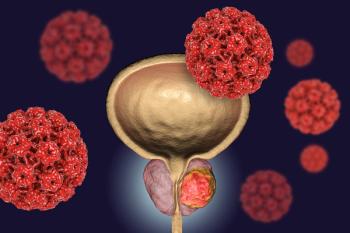
Frontline olaparib plus abiraterone/prednisone improved progression-free survival and responses in patients with metastatic castration-resistant prostate cancer compared with each of the components of the therapy alone.

Frontline olaparib plus abiraterone/prednisone improved progression-free survival and responses in patients with metastatic castration-resistant prostate cancer compared with each of the components of the therapy alone.

The median overall survival among those treated with tisagenlecleucel was not reached, and the 36-month overall survival rate was 82%.

Using diagnostic CT scans to create palliation plans may save time and improve the patient experience.

Although survival is improving overall, disparities continue to grow.

Sacituzumab govitecan improved overall survival vs treatment of physician’s choice in pretreated, endocrine-resistant, hormone receptor–positive, HER2-negative metastatic breast cancer.

Patients with ovarian cancer who received hyperthermic intraperitoneal chemotherapy with cytoreductive surgery did not experience worse health-related quality of life, according to investigators.

In the all-comer population, the overall response rate was 33.8%, including a complete response rate of 7.5% and a partial response rate of 26.3%.

Extended follow-up of the CheckMate 274 trial showed continued efficacy with nivolumab in patients with muscle-invasive urothelial cancer who had undergone radical resection.

Camizestrant doubled progression-free survival compared with fulvestrant in patients with estrogen receptor–positive, HER2-negative advanced breast cancer.

Patients with treatment-naive extensive-stage small cell lung cancer showed encouraging clinical responses with pembrolizumab and etoposide after multiple years of follow-up.

Phase 3 findings from the IMpower010 trial show that patients with resected non–small cell lung cancer may achieve an overall survival benefit with atezolizumab.

Patients with relapsed/refractory large B-cell lymphoma continued to derive benefit from lisocabtagene maraleucel after 2 years of follow-up.

Patients with relapsed or refractory large B-cell lymphoma experienced improved overall survival following treatment with axicabtagene ciloleucel.

Selinexor demonstrated impressive efficacy in extending progression-free survival among patient with advanced or recurrent endometrial cancer, particularly among patients with wild-type p53 endometrial cancer.

Adding sacituzumab govitecan to second-line pembrolizumab garnered promising antitumor activity among patients with checkpoint inhibitor–naïve metastatic urothelial cancer.

PI3K-pathway mutations may predict an increased risk of secondary uterine cancer in patients receiving tamoxifen to treat primary breast cancer.

Overall, 71% of patients with AL amyloidosis and 33% of those with heavily pretreated multiple myeloma achieved a partial response or greater after receiving treatment with low dose venetoclax.

Germline variation may cause men of African descent to have a higher risk of prostate than men of European descent.

Whether or not obesity should be considered a risk factor for non-small lung cancer might be determined by how it is measured.

Patients with favorable-risk prostate cancer tended to move away from active surveillance to initiating treatment after receiving their Oncotype DX Genomic Prostate Score.

African American, Asian, and Hispanic patients with limited-stage small cell lung cancer displayed superior survival outcomes compared with White patients, indicating that race might be linked with survival in this disease.

Adjuvant radiation therapy treatment yielded strong results in reducing all-cause mortality in patients with high-risk prostate cancer.

Consider options like prophylactic medications and optimal fluid administration when giving a 4-drug regimen to treat patients with multiple myeloma, one expert says.

Cultural competence, multidisciplinary efforts with diverse faculty, and high-risk screening programs could help to address critical gaps and cancer disparities.

Whole-genome sequencing may hold the answers for patients with myeloma precursor conditions.

Personalized and adaptable treatment regimens seem to be the way forward in treating gastroesophageal cancer.

A 9-week trastuzumab regimen may be favorable for patients with HER2-positive early breast cancer who have low and intermediate risk factors.

New immunotherapy combinations are being explored in the small cell lung cancer space.

Edward S. Kim, MD, highlights the impact of osimertinib in the treatment of patients with EGFR-mutant non–small cell lung cancer, next steps with the agent, and the importance of early genetic testing to provide personalized care.

Two tests for homologous recombination deficiency have been FDA approved for patients with ovarian cancer, including myChoice CDx and FoundationOne CDx, and they produce important information that can be used to guide treatment decisions.

Published: April 27th 2022 | Updated:

Published: July 31st 2021 | Updated:

Published: August 15th 2022 | Updated:

Published: October 5th 2023 | Updated:

Published: August 4th 2021 | Updated:

Published: June 10th 2023 | Updated: